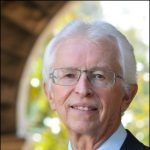North Korea from 30,000 feet
By Niko Milonopoulos, Siegfried S. Hecker, Robert Carlin | January 6, 2012
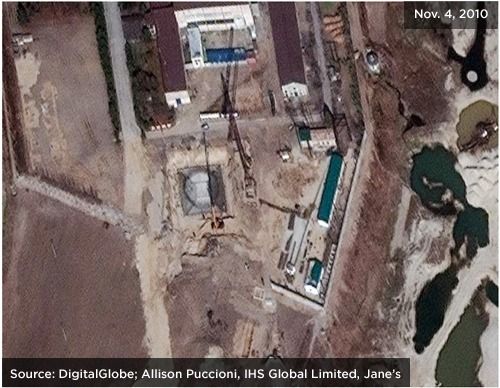
The first publicly available overhead imagery that suggested North Korea was constructing a new nuclear reactor at its Yongbyon complex appeared on November 4, 2010. Charles L. Pritchard, a former special envoy for negotiations with North Korea and the president of the Korea Economic Institute, along with a delegation from the institute provided the first confirmation of this construction after a visit to Yongbyon that week. The following week, Yongbyon officials told Stanford University’s John W. Lewis and two authors of this article (Hecker and Carlin) that the reactor was designed to be an experimental pressurized light water reactor (100 megawatts thermal, or 25-30 megawatts electric) to be fueled with low-enriched uranium fuel produced in a newly constructed centrifuge plant at the nearby Yongbyon fuel fabrication plant. The new reactor is being constructed on the former site of a cooling tower for a now-disabled, 5-megawatt electric, gas-cooled, graphite-moderated reactor that had been used to produce plutonium; the tower was demolished in 2008 as a step toward an eventual denuclearization agreement.
The Yongbyon construction site that Pritchard, Hecker, Carlin, and Lewis saw was essentially at the stage of development captured in the overhead image in Figure 1. The foundation slab had been poured, and the steel-reinforced concrete containment structure was about one meter high, on its way to a final height of 40 meters. Additional excavation was visible along with the construction of several new buildings that looked like storage sheds.
Figure 1
Overhead image that provided the first evidence of the construction
of a new reactor at the Yongbyon nuclear complex.
Overhead imagery tracks construction progress during the past year — from September 26, 2010, to November 3, 2011 — as shown in Figure 2. Early images indicated that the construction of this new light water reactor began in late September 2010, near the site of the destroyed cooling tower.
Figure 2
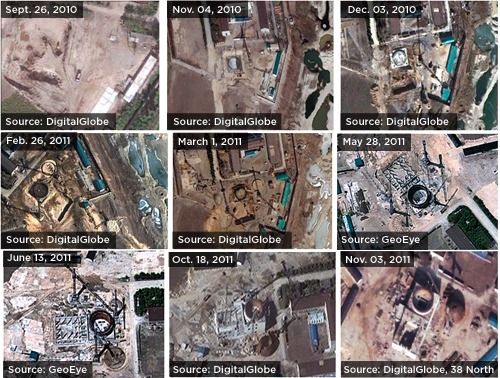
A time sequence of overhead images of the light water reactor
site tracking its development from September 2010 to November 2011.
The images show the rapid rate of construction of the reactor’s exterior, including the development of the reactor containment structure and the adjacent turbine generator hall. As the photos indicate, not much progress was made between December 2010 and April 2011, likely because of the harsh North Korean winter.
The September 23, 2011, annotated image shown in Figure 3 demonstrates that much has been done since May. The dashed lines represent underground cooling pipes running from a newly constructed pump house to the Kuryong River (as seen in a May 22 overhead not shown here). The reactor building containment dome is partially complete, and construction has begun on the turbine generator hall. Construction trucks can be seen in the right-hand corner of the image. On the north side of the reactor is the skeleton of a structure for transferring equipment into the reactor hall during annual maintenance outages.
Figure 3
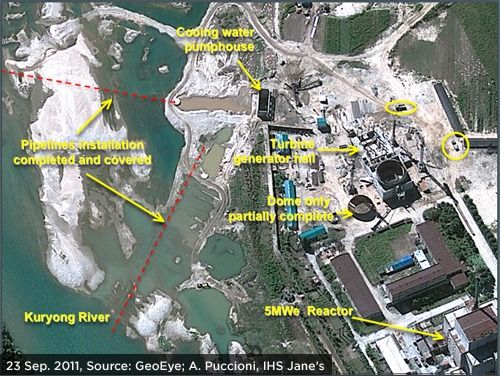
Annotated diagram of the new reactor site, shown in a photo indicating
significant progress in construction.
The latest available close-up overhead image, taken on November 14, 2011 (Figure 4), shows that many of the reactor’s external components are almost complete. Much progress has been made on the turbine generator hall; a traveling crane rail is already visible. The structure of the turbine pedestal inside the turbine building is already apparent. This is significant; it indicates that North Korea has a turbine design and possibly the ability to manufacture a turbine generator set that will fit within the dimensions of the turbine pedestal now under construction. The reactor building containment dome on the east side of the reactor’s containment structure is complete and will be placed on top of the containment structure once the large internal components of the reactor’s core have been inserted. For the first time, we see the appearance of small cylindrical components near the dome; these are likely parts of the pressure vessel that will go inside the containment structure.
Figure 4
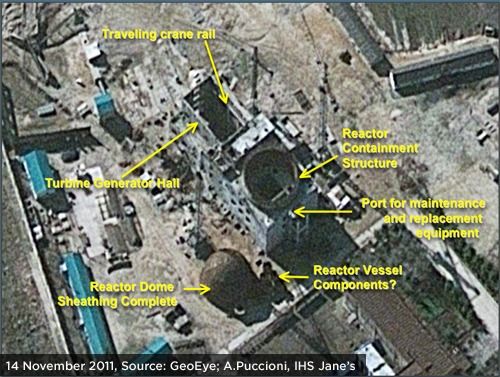
Close-up overhead image of the new reactor site. This is the most
up-to-date image publicly available.
Using overhead images from Figure 4, we constructed a 3-D model (Figure 5) of the light water reactor using the open-source program Google Sketchup. Based on the model, it is obvious that the reactor’s exterior is almost complete. The model also provides perspective on the size of the reactor, which will be 40 meters tall when completed and stretch 20 meters in diameter.
Figure 5
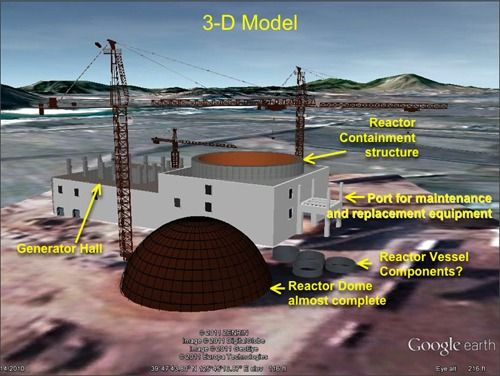
Three-dimensional model of the light water reactor based on the
latest satellite images.
Our analysis confirms Pyongyang’s plan to use this experimental reactor for electricity production. The rapid progress of construction also demonstrates that North Korea still has impressive manufacturing capabilities, in spite of the last two decades of economic downturn. However, we view this progress with alarm. Was the seismic analysis of the reactor site sufficiently rigorous? Did the regulatory authorities have the skills and independence required to license this reactor in such a short time period? And do Yongbyon specialists have sufficient experience with the very demanding materials requirements for the internal reactor components, including the pressure vessel, steam generator, piping, and fuel-cladding materials?
Although the North Koreans have constructed the outside of the reactor buildings at an impressive rate, we do not believe the reactor will be operational by the originally stated completion date in 2012. Analysis of overhead images shows the North Koreans are almost done with the easy part of constructing a reactor — the civil engineering work. Constructing and assembling the internal components of a pressurized water reactor are extremely difficult processes, successfully mastered by only a few technically advanced countries. The mechanical and electrical scope of the reactor’s construction are only starting, however, and those phases of the construction process will likely require at least two additional years.
The uranium enrichment centrifuge plant. Since Hecker, Carlin, and Lewis visited the newly constructed uranium enrichment plant in Yongbyon on November 12, 2010, as far as we know no foreigners have been given access to the facility. Our requests for a return visit have so far been denied. By tracking the construction of the Yongbyon centrifuge plant via overhead photography, however, we have concluded that North Korea must also have an undisclosed, pilot-scale centrifuge plant. Figure 6 shows the fuel fabrication plant as it existed in June 2009, only a few months after Pyongyang announced it would construct a pilot light water reactor and produce low-enriched uranium to power it. (The North Koreans previously denied having a uranium enrichment program.) Building 4, the fuel rod fabrication building, which housed the centrifuge plant we visited, looks the same as when the International Atomic Energy Agency inspectors were expelled in April 2009.
Figure 6
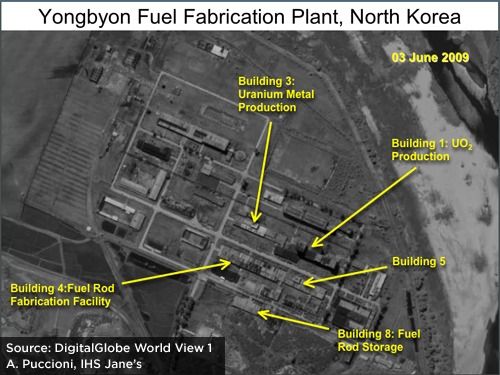
June 3, 2009 image of the fuel fabrication plant at the
Yongbyon nuclear complex.
On September 4, 2009, however, North Korea’s permanent representative to the United Nations announced that his country’s “experimental uranium enrichment has successfully been conducted to enter into completion phase.” This success must have been achieved at a different facility, because Building 4 could not have been readied in time. To house the 2,000 centrifuges we saw, the building was totally gutted and retrofitted with a clean, modern heating and air conditioning system; the exterior was refurbished and covered with a new blue metal roof. Moreover, we were told in November 2010 that the facility became operational only days before our arrival.
The fuel fabrication facility also had to be reworked and expanded to support the centrifuge plant. The now-disabled 5-megawatt electric reactor used uranium alloy metal fuel rods, which required the ability to convert uranium oxide to uranium tetrafluoride, which is in turn converted to uranium metal for the fuel. During the Agreed Framework’s freeze on nuclear activity, however, the hydrofluorination equipment for making uranium tetrafluoride corroded, and the building housing that equipment was abandoned. During the November 2010 visit, the chief process engineer told us that the North Koreans had replaced the old aqueous process for making uranium tetrafluouride with a new anhydrous process. He also said that they have installed fluorination equipment to turn uranium tetrafluoride into uranium hexafluoride, which is used as the feed gas for the centrifuges.
The overhead images in Figure 7 show that a number of buildings at the fuel fabrication plant were either retrofitted or newly constructed between June 2009 and November 2011. The building with the blue roof, Building 4, houses the centrifuge plant; the one on the lower left is believed to be a recreational building.
Figure 7
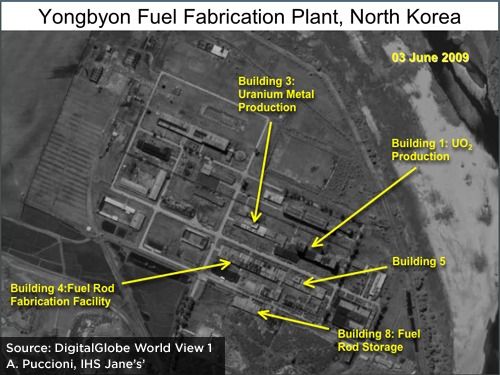
The fuel fabrication plant in November 2010, with annotations
identifying newly constructed buildings on the site between June 2009
and November 2011.
We are not certain what the other buildings contain, but equipment had to be housed for uranium tetrafluoride and uranium hexafluoride production, and an entirely new set of equipment had to be installed to make uranium oxide fuel pellets for the light water reactor. In addition, either zircaloy tubing or stainless steel tubing must be produced to clad the light water reactor fuel and fuel assemblies, which are very different from those previously used at Yongbyon.
Based on overhead-imagery analysis and our recollection of Building 4, we constructed the 3-D model of the centrifuge building shown in Figure 8. We have also labeled where the centrifuge hall, the control room, the recovery room, and the feed room are located within the building.
Figure 8
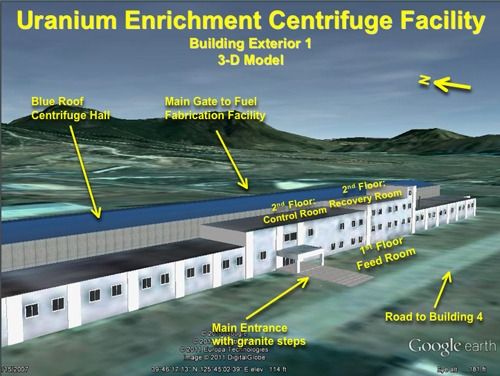
Three-dimensional model of Building 4 (the new uranium
enrichment centrifuge plant) in the fuel fabrication plant, created using
the latest satellite images.
Figure 9 is a rough schematic of the interior layout of the building. In the November 2010 visit, we observed approximately 2,000 centrifuges, divided into six cascades, from the second-floor observation platform identified in the diagram. Unless Pyongyang allows access to this facility, however, the world will not know if it is fully operational — nor will the world know much about the sophistication of other undisclosed facilities.
Figure 9
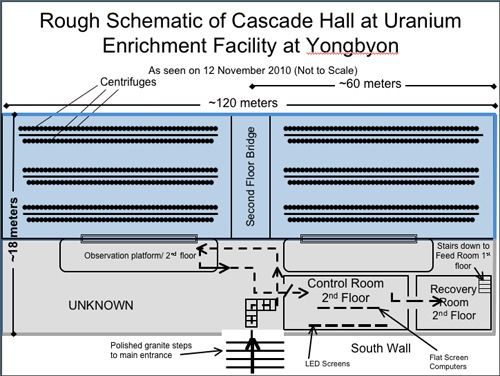
A rough schematic of the floor plan for the cascade hall at the
uranium enrichment centrifuge facility (Building 4) in Yongbyon, as of
Nov. 12, 2010.
How will Kim Jong-il’s death influence Pyongyang’s nuclear calculus? Though probably less cataclysmic than some observers anticipated, the death of leader Kim Jong-il in December has introduced new uncertainties into the North Korean picture. There have been notable continuities in Pyongyang’s perspective and basic policies over the past 50 years, and we expect those to remain in place. For example, the North has always seen itself as besieged on all sides, without permanent, trustworthy allies. That has made it suspicious of foreign advice and highly resistant to outside blandishments. With young Kim Jong-un at the helm, Pyongyang may be more susceptible to both external and internal developments. Nevertheless, without significant change in the external security environment — probably much more change than either Seoul or Washington can deliver — we would expect the North to remain a tough customer to deal with.
Perhaps the greatest challenge at the moment is to divine how internal dynamics during the political succession — even one well-scripted and moving apace, as the North’s seems to be — might nudge national security decisions one way or the other. In the case of the nuclear issues, the boundaries that we once thought we understood have now become harder to discern. One concern is that the likelihood of nuclear or missile tests over the next year may have grown.
During an October 2010 military parade, Pyongyang displayed a new class of road-mobile, intermediate-range ballistic missiles: the so-called “Musudan,” capable of being armed with a nuclear payload and with an estimated range of up to 3,000 kilometers. The Musudan is derived from the Soviet 1968 submarine-launched SS-N-6 missile. Although it has not been flight-tested, the Musudan would represent a major escalation of North Korea’s nuclear threat if Pyongyang is able to build a miniaturized nuclear warhead to fit it — a feat that we believe cannot be accomplished with confidence without at least one additional nuclear test.
Kim Jong-il’s apparent attempts to avoid crisis, preserve “stability,” and support the then-envisioned succession process has been overtaken by his mortality. In the current leadership circumstances, Pyongyang’s definition of stability might be quite different. Certainly, the North’s early media commentaries in the wake of Kim’s death highlighted as one of his signal accomplishments the country’s becoming a nuclear weapons state — a not unexpected emphasis, but not a hopeful signal, nevertheless. (In contrast, after the transition from Kim Il-sung to Kim Jong-il, the North repeatedly maintained that denuclearization of the Korean Peninsula was one of Kim Il-sung’s deathbed wishes.)
Further complicating the picture is the North’s long-term fixation on light water reactors as a solution to its severe energy problem. Pyongyang’s goal of energy independence and security, which is married to the notion that a nuclear power industry is a potent political symbol, may not be something that Kim Jong-un is willing to abandon. Unless that idea is either broken or an alternative is supplied (something other than heavy fuel oil, which has become a tattered Band-Aid), the nuclear energy issue will probably remain unresolved. The United States should not challenge Pyongyang’s right to have nuclear electricity but instead provide a more pragmatic energy solution.
When the Korean Peninsula Energy Development Organization (KEDO) still existed and was confidentially reviewing options other than nuclear power with Pyongyang, the most promising substitute was natural gas power plants. (The KEDO organization was established as part of the Agreed Framework to provide North Korea with two modern light water reactors, but it was effectively terminated in 2002 after the Bush administration accused Pyongyang of cheating on the agreement.) The problem, of course, was that the North had no infrastructure to handle — much less access to a supply of — natural gas. Recent Russian-South Korean-North Korean consideration of a Russian pipeline might provide new opportunities to revisit the issue.
On the upside, diminution of what Pyongyang perceives as an external threat could provide circumstances in which the new leadership might entertain bolder moves — further encouraging tension reduction and experimenting with new approaches on the economic front. For years, the Chinese have advised Washington that even Deng Xiaoping could not have moved ahead with his economic reform program if he had not first been able to reduce the external threats Beijing feared from the Soviet Union and the United States. By encouraging improvements in the security environment, Washington and Seoul could possibly set in motion a series of mutually reinforcing steps that would finally get at legitimate US concerns about both the North’s nuclear weapon and missile programs.
The authors wish to thank Dr. Chaim Braun, Stanford University, and Allison Puccioni, IHS Jane’s, for their valuable input.
Together, we make the world safer.
The Bulletin elevates expert voices above the noise. But as an independent nonprofit organization, our operations depend on the support of readers like you. Help us continue to deliver quality journalism that holds leaders accountable. Your support of our work at any level is important. In return, we promise our coverage will be understandable, influential, vigilant, solution-oriented, and fair-minded. Together we can make a difference.
Topics: Nuclear Energy, Nuclear Weapons, Opinion

